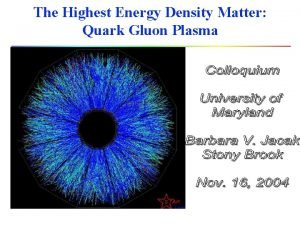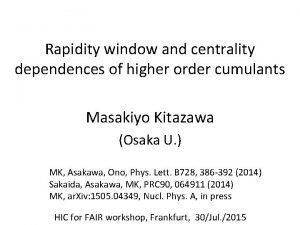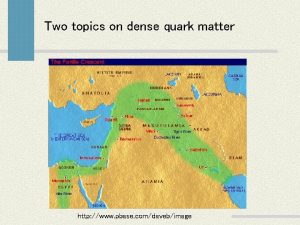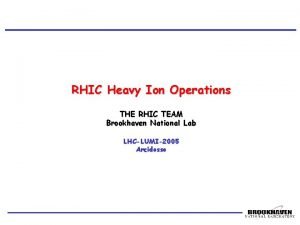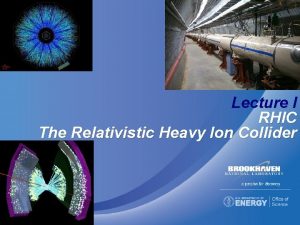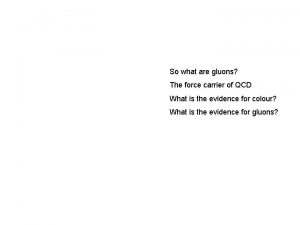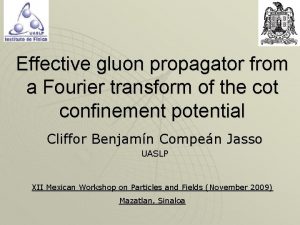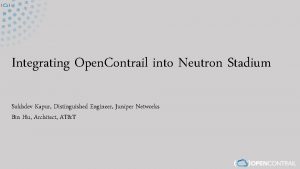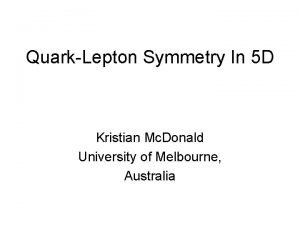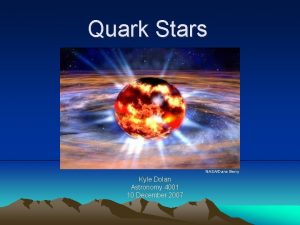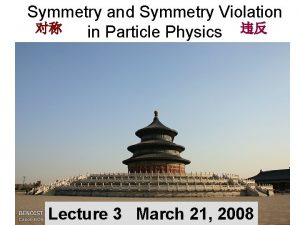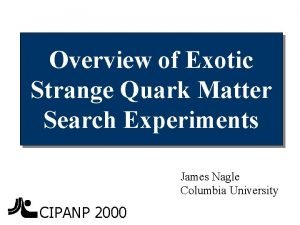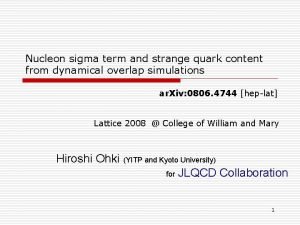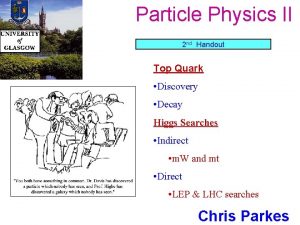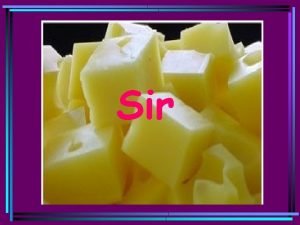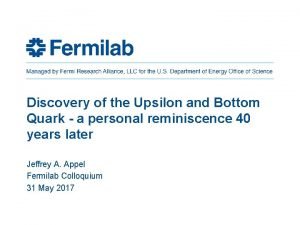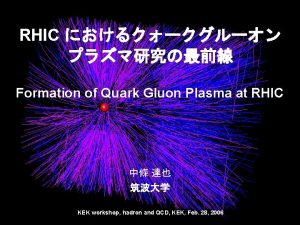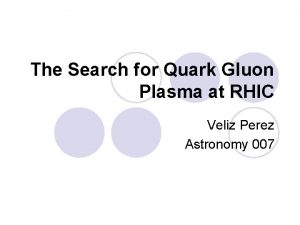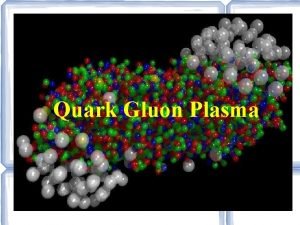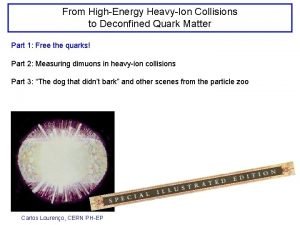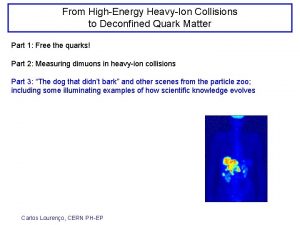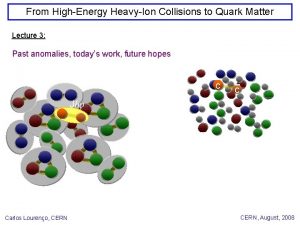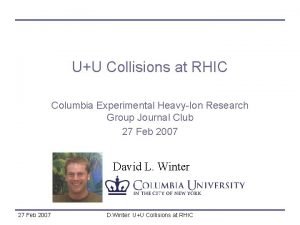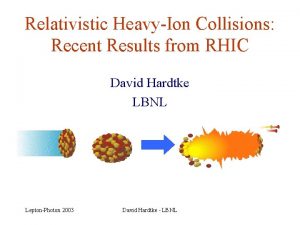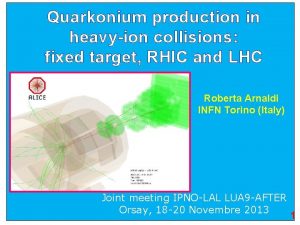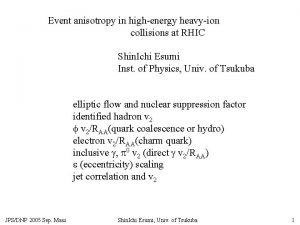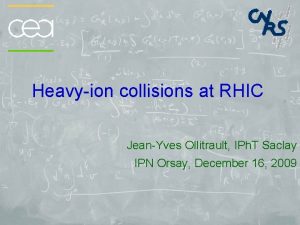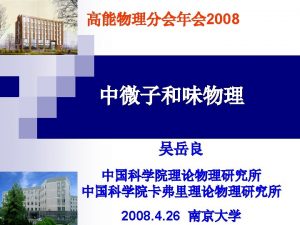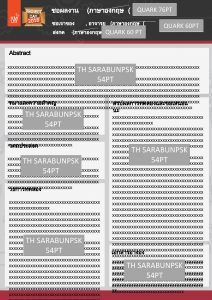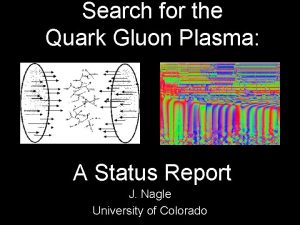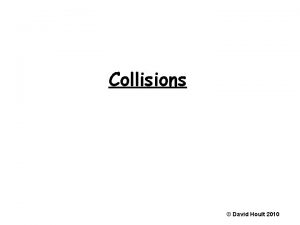HeavyIon Collisions at RHIC Search for Quark Gluon


















- Slides: 18

Heavy-Ion Collisions at RHIC ~Search for Quark Gluon Plasma~ Takao Sakaguchi Brookhaven National Laboratory 米国ブルックヘブン国立研究所 坂口貴男 Outline of talk • Motivation of Quark Gluon Plasma Search • Accelerator and detectors • Dynamics and Global feature of Heavy ion collisions • Hard scattering as a new probe • Direct Photon, Jet and Heavy Quark results • Summary and Future

Why do we carry out Heavy Ion Collisions? Why Quark Gluon Plasma (QGP) ? • Believe it or not! • It existed in the early universe. • Understanding fundamental QCD problem • Quark confinement • Origin of proton (hadron) Mass • Both questions rely on low Q 2 region, where as(Q 2)>1 • QGP is a phase where bare strong interaction plays significant role • Quarks and gluons are free from hadron “bag” • Study dynamical behavior of strongly interacting system

RHIC at BNL Long Island, New York PHENIX PHOBOS STAR BRAHMS Axial Field Solenoidal fieldtarget geometry 2 Spectrometers - fixed Resolution & Rates. Rings, TOF Large Tracking Solid Angle Tracking. TOF, RICH Magnets, Chambers, Si High -Strips, Si Multiplicity 2 Central Arms, 2 Forward Arms TPC’s, every Si-Vertex Run started in 2000. Around 6 months running year. Tracking TEC, RICH, EM Cal, Si, TOF, -ID RICH, EM Cal, TOF Statistics aka PHENIX experiment. “Table-top” 2 Arm Spectrometer Magnet, Paddle Trigger Counter Species Au+Au s 1/2 [Ge. V ] TOF 130 200 Ldt Ntot (sampled) 1 b-1 265 b Spectrometer -1 9. 1 b Octagon+Vertex -1 Data Size 10 M 3 TB 1. 8 G 120 TB 4 TB Ion collider • First Heavy • 3. 83 km circumference p+p 200 0. 5 pb-1 10 G 50 TB • 106 ns bunch crossing d+Au 200 2. 74 nb-1 5. 5 G 46 TB • Top Energy: -1 Cu+Cu 200 3. 06 nb 1. 1 G • 500 Ge. V for p+p Cu+Cu 63 0. 16 nb-1 • 200 Ge. V for Au+Au • Luminosity Leptons, Photons, and Hadrons in Measurements of Hadronic observables 26 cm-2 s-1 • Au+Au: 2 x 10 selected solid angles (especially muons) using a large acceptance spectrometer 32 cm-2 s-1 • production p+p : 2 x 10 Inclusive particle over Low p charged hadrons t Simultaneous detection of phase transition Event-by-event analyses of global a large Multiplicity in 4 & Particle Correlations rapidity and pt range (polarized) phenomena (e– coincidences) Ring Counters Au+Au 63 58 M observables, hadronic spectra and jets

Time profile of heavy ion collisions Gluon Plasma • QGP phase Gold ions “pass through” each other • • Large-x partons fly over. Mid-rapidity region is full of small-x gluons • High energy heavy ion collisions = Gluonic matter collisions • Turns into Gluon plasma • Gluon -> quark + anti-quark -> QGP • Cooling QGP -> Mixed phase -> Hadronic stage • Global Feature • • Energy density: 5. 7 Ge. V/fm 3 @ Au+Au s. NN=200 Ge. V (ref. LQCD: reaches plateau at 2 -3 Ge. V/fm 3) Temperature T=178 Me. V (Threshold) Mixed phase Hadronization + Expansion

New probe to HEHIC: Hard scattering • • Hard scattering process well described by NLO p. QCD calculation at high Q 2 Unique Signature at high energy: Hard scattering cross-section is large • Jet and Direct photon • Heavy Quark production: Charm(onium), Bottom(onium) In A+B collisions---TAB Scaling • C Cross section in A+B collisions = TAB(b) p+p collisions • TAB(b): Overlap integral of nuclear profile functions Number of binary collisions • =ABP 1 • Can be calculated by Geometrical description of Nucleus x. P 1 1 P 2 A c X x 2 P 2 d B Centrality 0% (Central) Centrality 100% (peripheral) A B looking from top view along beam axis Proportional to number of participated nucleons

Calibrating Hard scattering • High p. T Direct photon in Au+Au at s. NN=200 Ge. V Leading Order (LO) • Electromagnetic probes bring out information on the stage it is emitted • Direct access to hard scattering (p. T>4 Ge. V/c) • Yellow bands show error due to three different cutoff scale of NLO p. QCD scaled by number of binary collisions (Ncoll) Next-to-Leading Order (NLO) • NLO p. QCD agrees very well with measurement • First measurement of hard scattered direct photon in heavy ion collisions! PHENIX, nucl-ex/0503003 Hard scattering cross-section in nucleus-nucleus collisions has been calibrated

Jet as a probe of dense medium • Parton may change its momentum in hot dense medium • Energy loss through Gluon radiation, etc. • Reconstruction of Jet in Au+Au is impossible • Trigger Leading particle of Jet • Angle correlation, Energy, momentum, etc. may reflect Jet kinematics Fragmentation: Yield [Ge. V-1 c] 0 without energy loss 0 with energy loss Energy loss =Yield suppress p. T [Ge. V/c] X. -N. , Wang, PRC 58 (1998)2321

High p. T Identified hadron spectra(I) • Produced in initial hard scattering process • Should scale with Ncoll if no additional process exists • In peripheral Au+Au collisions, yield is consistent with p+p collisions scaled by Ncoll 70 -80% Centrality 0 -10% Centrality (peripheral) (Central) • In Central Au+Au collisions, yield is significantly lower than p+p • Energy loss of hard scattered parton in hot and dense medium? pp. T [Ge. V/c] PHENIX, PRL 91, 072301 (2003) s. NN=200 Ge. V

High p. T Identified hadron spectra(II) • Nuclear Modification Factor: RAA • Ratio of per-collision-yield to p+p • Hard scattering only: ratio is 1 =1 << 1 • Is suppression due to final state interaction? • Au+Au Direct photon: RAA= 1 • Suppression is final state effect d+Au Minimum bias 200 Ge. V 0 RAA /Rd. A • Peripheral Au+Au, Minimum bias d+Au: • Central Au+Au: Au+Au Peripheral • Energy loss of parton in hot dense medium BRAHMS, PRL 91, 072305 (2003) Au+Au Central • Medium expands in longitudinal direction as well? • Suppression at high rapidity region • Answer is Yes! PHENIX, PRL 91, 072301 (2003) PHENIX, PRL 91, 072303 (2003)

Modification of away side Jet • Correlation of back-to-back jets through high p. T hadrons • Trigger leading high p. T (4<p. T<6) hadrons STAR PRL 90, 082302 (2003) Trigger particles sit at 0. Au + Au peripheral near • Angle correlation of lower p. T (2<p. T<trig) particles with triggered hadrons • p+p and peripheral Au+Au: • Near side yield = Away side yield • Central Au+Au: away side particles suppressed. • Energy loss of away side Jet • Near side jet produced almost at surface of medium away Au + Au central away Coll im regi ated on • Near side: In Same Cone of leading • Away side: In Cone of associated jet Histogram: p+p, Black Points: Au+Au Blue Line: Mixed background

Where is away side Jet ? Near(Trigger) Side Away Side (Folded into 0 -p ) Interpretation. . Wake effect or “sonic boom” hep-ph/0411315 Casalderrey-Solana, Shuryak, Teaney Correlations of Jets with flowing medium W. Holtzmann for PHENIX, WWND, 2005 Even lower p. T associated particles (1. 0<p. T<2. 5) hep-ph/0411341 Armesto, Salgado, Wiedemann Strong Modification of away-side Jet observed! Dawn of Jet tomography

Heavy Quark(onium) • • • Charm or bottom produced in hard scattering process Energy loss of light quark is mostly due to gluon radiation (analogous to Bremsstrahlung) • How about heavier quarks? Collisional energy loss? Charmonium in hot dense medium will be: • Suppressed due to dissociation (debye screening) • D mesons , Y’, c Large Q value needed (>≈3 Ge. V) Enhanced due to coalescence of c-cbar p. QCD should work better! J/ (M=3. 1 Ge. V/c 2)

Single heavy quark measurement • Experimentally observe the decay products of Heavy Flavor particles (e. g. D-mesons) • STAR • PHENIX • Direct D mesons hadronic • Singledecay electron • Hadronic channels D K , D 0 + decay - 0 channels in d+Au measurements in p+p, D e( ) d+Au, K n • D 0 K • Semi-leptonic decays e Au+Au s. NN = 130, 200, 62. 4 Ge. V Phys. Rev. Lett. 88, 192303 (2002) Meson D±, D 0 Mass 1869(1865) Ge. V BR D 0 --> K+ - (3. 85 ± 0. 10) % BR D --> e+ +X 17. 2(6. 7) % BR D --> + +X 6. 6 % • D± K • D*± D 0 • Single electron measurements in p+p, d+Au

Single electron Result • Strong modification of the spectral shape in Au+Au is observed at high p. T • Statistics insufficient to quantify centrality dependence • Possibility of different energy loss mechanism? RAA of Integrated CS (2. 5<p. T<5. 0 Ge. V/c). PHENIX PRELIMINARY T. Tabaru for PHENIX, ICPAQGP 05, 2005

Where is suppressed Charm? • Particles boosted by pressure gradients in collision area • Elliptic shape turns into anisotropic flow • Positive flow(v 2) = Collective motion with expanding system = Hint of equilibrium d. N/d =v 0/(2 )+v 2 cos(2 ) / +… • Energy loss of charm implies interaction of charm with the medium • Charm participate in collective motion! Strong indication of “quark level” early equilibrium STAR, nucl-ex/0411007, Theory curves from: Greco, Ko, Rapp: Phys. Lett. B 595 (2004) 202

Charmonium results First J/ ->ee measurement in heavy ion collisions! Phys. Rev. C 69, 014901, 2004 Not enough statistics to make definitive conclusions J/ ->ee R. L. Thews, M. Schroedter, J. Rafelski, Phys Rev C 63, 054905 Plasma Coalescence Model y = 1. 0 Au+Au s. NN=200 Ge. V y = 4. 0 Binary Scaling Stat. Model Andronic et al nucl-th/0303036 Absorption (Nuclear + QGP) + final-state coalescence Absorption (Nuclear + QGP) L. Grandchamp, R. Rapp, Nucl Phys A 709, 415; Phys Lett B 523, 60

• Summary Hard scattering (p. QCD) as new probe for Np. QCD QGP • • Cross section is significantly large at RHIC. Calculable by p. QCD Calibrated by Direct photon • First measurement in high energy heavy ion collisions • Jet modification • High p. T particle yield (fragment of Jet) suppression in central Au+Au collisions • Hot dense medium expanding both transverse and longitudinal direction • • Away side jet is strongly modified Hint of Charm suppression and flow in Au+Au collisions • Needs more statistics to conclude Future Outlook • High Statistics Run 4 Au+Au data is now in analysis • • • 10 times statistics: ~ 1. 5 G events accumulated Thermal radiation on top of p. QCD photon -> Direct emission from QGP 700 J/ ’s expected -> precise measurement of charmonium Complemented by Run 5 Cu+Cu data on system size dependence Hard scattering will be even more powerful probe at LHC

RHIC Collaborations STAR
 Quark gluon
Quark gluon Quark gluon plasma
Quark gluon plasma Quark gluon plasma
Quark gluon plasma Quark gluon
Quark gluon Rhic brookhaven
Rhic brookhaven Rhic ags users meeting 2020
Rhic ags users meeting 2020 Rhic
Rhic Rhic
Rhic Gluon force carrier
Gluon force carrier Gluon propagator
Gluon propagator Gluon plugin
Gluon plugin Quark lepton symmetry
Quark lepton symmetry Quark astronomy
Quark astronomy A charm quark has a charge of approximately
A charm quark has a charge of approximately Quark matter
Quark matter Sigma quark composition
Sigma quark composition Top quark decay
Top quark decay Sirutka u prahu vindija
Sirutka u prahu vindija Quark names
Quark names
